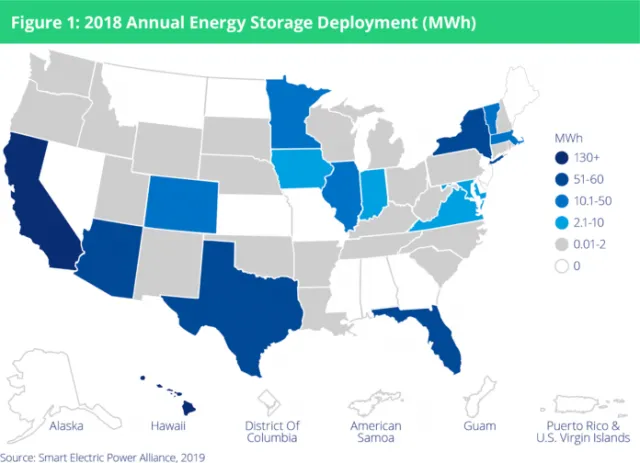SEPA Storage Report Underscores Rising Deployments, Increased Range Of Applications
Aug 9, 2019 04:26 PM ET

A new Smart Electric Power Alliance (SEPA) report finds that the U.S. energy storage market is healthy and primed for continued growth, with interconnected capacity growing significantly in 2018.
The report, the 2019 Utility Energy Storage Market Snapshot, shows that in 2018, a total of 760.3 MWh of energy storage was interconnected, representing a 44.9% increase over 2017, bringing the cumulative energy storage total capacity to 1,966.6 MWh nationwide. Residential storage deployments grew 500.1% in 2018; non-residential storage showed strong growth of 34.9%; and utility-supply storage remained the largest segment, at 394.8 MWh, and grew by 11.3%.
“Energy storage deployments are accelerating, driven by increasingly compelling economics, favorable state policies, and residential programs in California, Hawaii, and Vermont,” says Mac Keller, co-lead author and research associate at SEPA. “Beyond traditional backup generation, battery storage is able to provide ancillary services, ramping, smoothing and peaking services to meet the demands of an increasingly diversified and distributed electrical system. Based on these expanded applications, coupled with the emergence of long-duration technologies, the energy storage market is primed for continued growth.”
Now in its third year, the Utility Energy Storage Market Snapshot relies on interconnection data and market insights obtained directly from 211 electric utilities, representing approximately 56% of all customer accounts in the U.S.
SEPA has outlined the following other key takeaways from the report:
- Investor-owned utilities deployed the most storage of any utility type, accounting for 64.3% of the total market in 2018, with public power utilities and electric cooperatives also experiencing strong growth, at 1435.5% and 154.4%, respectively, over 2017.
- Of the 211 utilities that responded to the survey, 94 had at least one energy storage installation in their service territory as of the end of 2018. One-quarter of those deployed their first storage project in 2018.
- The business case for certain lithium-ion battery storage applications has become more attractive as the price of lithium-ion storage assets has declined by 72.9% since 2013.

SEPA has also released top 10 rankings recognizing utilities with the most overall energy storage capacity interconnected in 2018, according to total MWh and watt-hours per customer account (Wh/C).
In terms of MWh, Southern California Edison came in first with 154.3 MWh, Kauai Island Utility Cooperative in Hawaii was second with 102 MWh, and Pacific Gas & Electric ranked third with 73.2 MWh.
For Wh/C, Kauai Island Utility Cooperative came in first, interconnecting an impressive 3,037.6 Wh/C in 2018. Massachusetts-based Sterling Municipal Light Department and the City of Holyoke, Mass., ranked second and third, respectively, with 523.1 Wh/C and 341.6 Wh/C.
Also read

